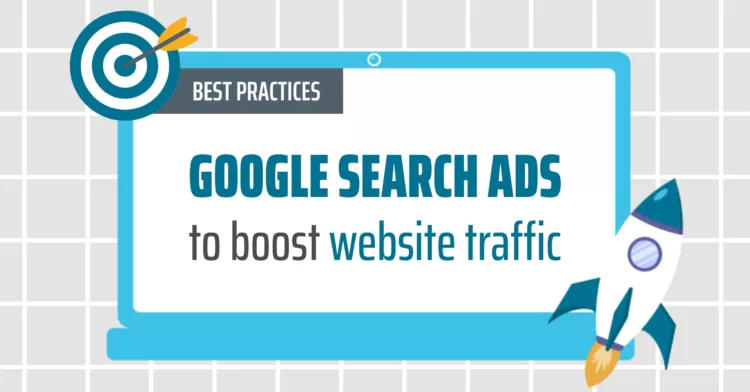Google search ads: 6 best practices to boost website traffic

This article discusses the best practices to follow in Google search ads. The best practices include writing multiple headlines and descriptions, using the right keyword match types, and making ads for native and mobile devices. The importance of Dynamic Search Ads, crafting a good landing page, and ad testing is also explained.
Google search ads are a powerful tool to attract more prospects to your website. But your search campaign proves ineffective if you don't know how to optimise Google ads to encourage more clicks and conversions.
As a marketer, you should consider the six Google search ads best practices below to get the best out of your ad spend.
1. Have multiple headlines and descriptions
One striking feature of Google Ads is tailoring ads for different customers based on available headlines and descriptions.
When launching a new campaign, enter several headlines and descriptions related to your main offerings and customer needs. Google Ads will combine these assets to build flexible ads that deliver more relevant content to potential customers.
To better understand how Google Ads creates custom ad combinations, let's look at the image below:
Each ad combination has three headlines and two descriptions. But the more headlines and descriptions you input, the more you Google Ads craft ad combinations that more closely fit your potential searchers' queries. This will help increase click-through rates, boosting your overall campaign performance.
To build an effective ad campaign with headlines and descriptions, consider some tips below:
For Headlines:
- 8-10 headlines are ideal for building diverse ad combinations.
- Include at least five unique headlines to increase the likelihood of more ad combinations showing up on Google. Avoid using the same terms or phrases, as they will prevent Google Ads from generating many ad combinations.
- Use Google's suggestion tools to build popular keywords around your main offerings. But limit the popular keyword density to 2-3 headings to enhance ads performance.
- Headlines should focus on your company's special offers, sales promotions, taglines, or delivery and refund policies.
- No more than 30 characters for each heading. Also, diversify your headlines' length.
For Descriptions:
- No more than four descriptions per ad campaign. Ensure at least two descriptions are unique and work well together in ad combinations.
- No more than 90 characters for each description. Also, build descriptions of different lengths.
- Descriptions should highlight calls to action (CTAs) and outstanding features that do not appear in headlines.
To test if your use of headlines and descriptions is effective, look at your ad strength as shown in the image below:
Ensure you include the top relevant keywords to your website. Also, make headlines and descriptions unique but still aligned with your campaign goals and resolve customers' pain points.
Improving ads strength helps you get the right ads for potential customers and boost clicks and conversion rates.
2. Use the right keyword match types
Keyword match types tell Google how you want your ads to match search queries. Choosing the right match types helps your ad campaign target the right audience. Thus, it improves search relevance, gets higher click-through rates, and increases your campaign's success.
Google now offers three keyword match type options: broad match, phrase match, and exact match. Below is the main difference between these types and their examples:
Let's dive into when each type performs best and how to optimise them for your intents:
Broad match
This is a default keyword match type of Google Ads. Broad match allows your ads to show up on search queries that include synonyms, misspellings, and similar variations.
This match type aligns your keywords with the broadest potential searches. So adopt broad match if you want your ads to get maximum impressions and potentially attract a significant number of visitors to your website.
But broad-match keywords can engage non-target audiences in your ads. So pair broad match with Smart Bidding to reach more target customers. Coupled with Smart Bidding, broad match can filter out irrelevant search terms.
Phrase match
This match type shows ads for searches that include your keyword terms in the correct order. It also matches your ads with search queries that add words after or before your keyword phrases.
So phrase match helps ads target the right niche better than broad match and mitigate the chance of matching irrelevant searches.
For this reason, consider phrase match if you want large but still high-quality traffic with higher conversions.
Exact match
This match type previously only allowed searches to match exactly with word-by-word keyphrases. But Google now extends this match type's usage to your keyword's close variants. Hence, it increases the chance of reaching more target searchers.
Among the three match types, exact match gives your ads the highest search relevance but the lowest reach. So use exact match if you expect the most targeted traffic with the highest chance of converting to your website.
Tip: To see which performs best, set up a Google Ads Dashboard showing the performance from these three different keyword match types. A pivot table or bar chart will summarize the results nicely.
3. Make ads for native and mobile devices
According to Invesp, 53% of paid search clicks come from mobile users. Therefore, tweak Google ads for native and mobile devices if you don't want to lose the potential audience therein.
To make your Google Ads strategy on mobile and native devices effective, consider some important points below:
- Not all your prospects conduct a search on mobile devices. So, you should first explore which customer groups prefer searching on mobile and which keywords they prefer finding. Then craft mobile-based paid ads that include those keywords.
- Ad copies for mobile devices should be compelling but still deliver relevant messages to customers within the space available on mobile devices. Further, your ads must highlight your business’s unique selling points, CTAs, and other key features that can move prospects down your sales funnel.
- Use Google’s IF function to customise your ads’ content based on who your customers are, which device they use to search your keywords, and when they use the device. Look at an example below to see how this function works:
There's a lot to consider if you want to build successful ads for native and mobile devices. Thus, ponder over all essential factors to devise a good Google Ads strategy that optimises mobile-based ads.
4. Use dynamic search ads
Dynamic search ads (DSAs) are adverts built by Google using your website content, not keywords.
The idea behind DSAs is simple. When someone searches for terms that closely match popular phrases or titles on your website, Google Ads automatically selects a relevant landing page for a display URL. The system also tailors a clear, engaging ad headline related to those search queries. Then, Google Ads will include such a page URL and headline in DSAs.
This way, you won’t waste time crafting headlines for your ads manually. It also ensures you continue to direct prospects to exactly what they want to find on your site.
Look at a DSA example below to see how a DSA displays on Google:
As Google dynamically picks up relevant headlines and landing pages for your ads, the only thing to do is build creative descriptions that encourage more clicks.
But we don't recommend DSAs for underdeveloped websites. As mentioned, DSAs perform depending on your website content. So if you have well-developed sites with rich content, the chance to build ads closely matching search queries will be high. Otherwise, you may create ineffective ads and miss target audiences.
5. Build a well-designed landing page
Getting your landing page design right is critical to building an online presence. It gives visitors the first positive impression of your offerings and ensures that they convert.
Landing pages are single web pages that show up after customers click on online ads. So when designing landing pages, use the same keywords and CTAs as in your ads to make your messages consistent from ads to the site.
Further, landing pages often direct visitors to a particular action, like email subscriptions or making a purchase. So for each landing page on your site, only focus on one product line or service with a clear, simple CTA.
Write a landing page copy with a single desired action that aligns with the prospects’ needs.
Besides content, use images with professional looks and speed up page load time. Remember to build responsive landing pages for mobile devices.
6. Test your ads often
Your search campaign fails if you don’t monitor and test your ads often. Measuring Google Ads performance is essential to know how your ads perform and get deeper insights into user intent, responses to ads, and more.
Based on what you get from frequent tests, you can understand which factors make your ads successful or whether any change is needed to mitigate poor performance.
You need a tracking plan that clarifies what events (i.e., user actions) to track and which tracking methods to use. Then, connect your ads with some advertising analytics software like Google Analytics or Moat Analytics. Such software analyses your ads’ performance and how users interact with your campaign to give you insightful reports.
In addition to the ads, make sure to test your landing pages. Play around with different design elements and see how that affects conversion rates.
In summary
Following the Google search ads best practices is essential if you want to optimise the ROI of your campaigns.
Use multiple headlines and descriptions as well as the right match type to enhance search relevance and campaign performance. Besides, consider dynamic search ads and optimise ads for mobile devices.
Don’t engage your high-qualified customers with poorly-designed landing pages. Also, check your ads frequently to know whether they work effectively and make essential adjustments as needed to improve your ad strategy.
Apart from the mentioned Google search ads best practices, you can test other tips that suit your ad purposes to deliver the desired outcomes for your site.
Author Bio
- Ashish Gupta - Co-Founder & CEO - Polymer Search - Former Tech Lead for Machine Learning at Google AdWords (6 years) and a quant developer on Wall Street. Co-Founder & CEO of Polymer Search, the first no-code solution to make structured data more accessible.
Top 7 social media trends to follow into 2023
Next round of new extensions aka ICANN’s vaporware
